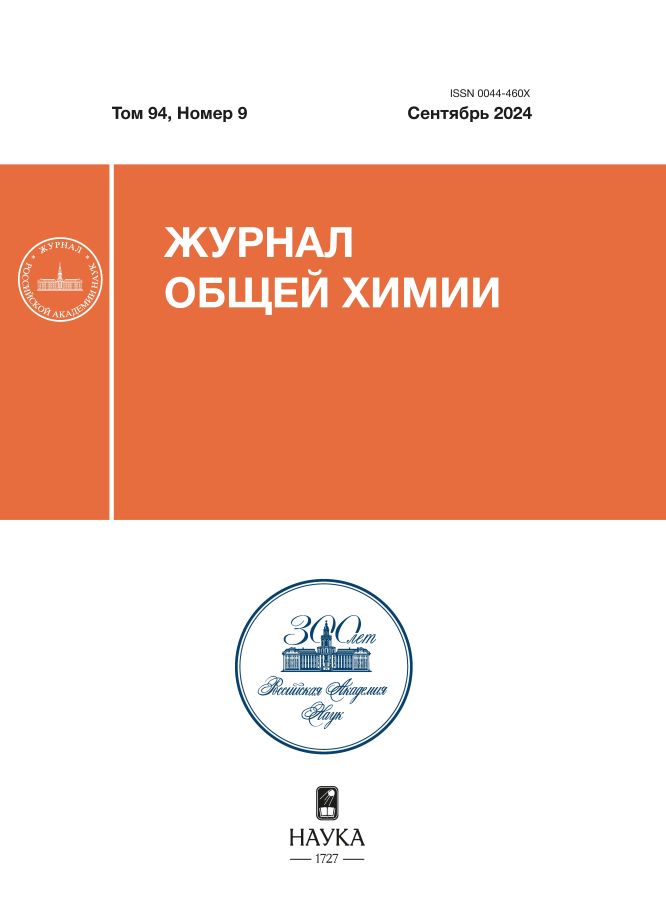Том 94, № 9 (2024)
Articles
Synthesis of New Chalcogenazolo[3,2-a]pyridinium Derivatives by the Annulation Reaction of Vinyl Heteroatom Compounds with Pyridine-2-chalcogenyl Halides
Аннотация
Based on the annulation reactions of pyridine-2-chalcogenyl halides with a number of vinyl heteroatomic compounds (divinyl and alkyl vinyl ethers, divinyl sulfide, 2-vinylsulfanylethanol, tetravinylsilane), effective methods have been developed for obtaining new 2,3-dihydro[1,3]thiazolo- and -selenazolo[3,2-a]pyridinium derivatives in high yields.
 949-957
949-957


Synthesis and Properties of N-Substituted Purpuric Acid Derivatives and Their 2-Thioanalogues
Аннотация
A new route was developed for the synthesis of N-substituted derivatives of purple acid based on the condensation of methylene-active barbituric acids with the corresponding derivatives of 5-hydroxyiminobarbituric acid. 2-Thioanalogs of purple acid were obtained for the first time using a similar method. The spectral properties and hydrolytic stability of the synthesized purpurates were studied.
 958-964
958-964


Destruction Features of Tetra(4-iodo-5-tert-butyl)phthalocyanine Under the Action of n-Butylamine in Benzene–DMSO Media
Аннотация
The properties of the newly synthesized tetra(4-iodo-5-tert-butyl)phthalocyanine were studied in the presence of n-butylamine in a benzene–dimethyl sulfoxide media. It was shown that the molecular form of tetra(4-iodo-5-tert-butyl)phthalocyanine and its proton transfer complex undergo degradation under the action of n-butylamine, which is described by various kinetic equations. The influence of the polarity and basicity of the media on the speed and activation parameters of the process was established and destruction schemes were proposed.
 965-972
965-972


Thermochemistry of Dissolution of 5,10,15,20-Tetrakis(1′-methylpyrid-4-yl)porphin Tetraiodide and 5,10,15,20-Tetrakis(1′-carboxymethylpyrid-4-yl)porphin Tetrachloride at 298.15 K
Аннотация
The heat effects of dissolution of 5,10,15,20-tetrakis(1′-methylpyrid-4-yl)porphine tetraiodide in water and aqueous KOH solution and 5,10,15,20-tetrakis(1′-carboxymethylpyrid-4-yl)porphine tetrachloride in aqueous alkali solution at a temperature of 298.15 K were measured by direct calorimetry. The values of the standard enthalpies of formation of 5,10,15,20-tetrakis(1′-methylpyrid-4-yl)porphine tetraiodide were calculated by the additive group method based on group systematics with the classification of Benson-type fragments, taking into account the influence of the primary environment of atoms.
 973-978
973-978


Complexes of Bromine and Its Derivatives with Nitrogen-Containing Donors: A Quantum Chemical Study
Аннотация
Structural and thermodynamic characteristics of molecular donor-acceptor complexes of BrCl, Br2, IBr with nitrogen-containing Lewis bases are computed by using quantum chemical method M06-2X/def2-TZVP in the gas phase, benzene and acetonitrile solutions in the framework of SMD model. It is shown that the polarity of the solvent significantly influences the structural features and stabilization of the complex with respect to the dissociation process. In case of BrCl complexes with all studied Lewis bases the three center four electron N–Br–Cl bond is realized in acetonitrile solution.
 979-986
979-986


Solubility of Curcumin in Water and Aqueous Solutions of Tetradecyltriphenylphosphonium Bromide with Formation of Protomicelles
Аннотация
By spectrophotometry studied the interaction of curcumin, a biologically important molecule, with tetradecyltriphenylphosphonium bromide in an aqueous environment depending on the concentration of surfactants in the premicellar and micellar ranges. Experiments were carried out with saturated solutions of curcumin under conditions of thermodynamic equilibrium of the solution with the dye precipitate. The solubility of curcumin in water has been clarified (about 2 µM). It has been shown that the process of solubilization of curcumin begins in the premicellar region of surfactants, is enhanced in the presence of adsorption protomicelles, but is most effective in the presence of ordinary micelles. The extinction coefficients of curcumin monomers in dimethyl sulfoxide, water and micellar solutions are determined. Based on experimental data, the limiting value of the solubilization capacity tetradecyltriphenylphosphonium bromide with respect to curcumin is calculated. The conductometry was used to determine the values of the critical micelle concentration (CMC) of the studied surfactant in the presence and absence of curcumin and confirm the theoretical conclusion that the CMC of the surfactants is reduced by the solubilizate.
 987-999
987-999


Synthesis and Comparative Study of Silicone Composites Containing Sodium Diclofenac Using New Types of Cross-Linking Agents
Аннотация
A new type of silicone composites in the form of films containing sodium diclofenac were obtained, which can potentially be used as transdermal patches. Glycerol and propylene glycol analogues of tetraethoxysilane, tetrakis(2,3-dihydroxypropoxy)silane and tetrakis(2-hydroxypropoxy)silane, were first used to cure polydimethylsiloxane with terminal hydroxyl groups (PDMS-OH) to obtain silicone composites. It was shown that these cross-linking agents have a number of advantages over tetraethoxysilane.
 1000-1010
1000-1010











